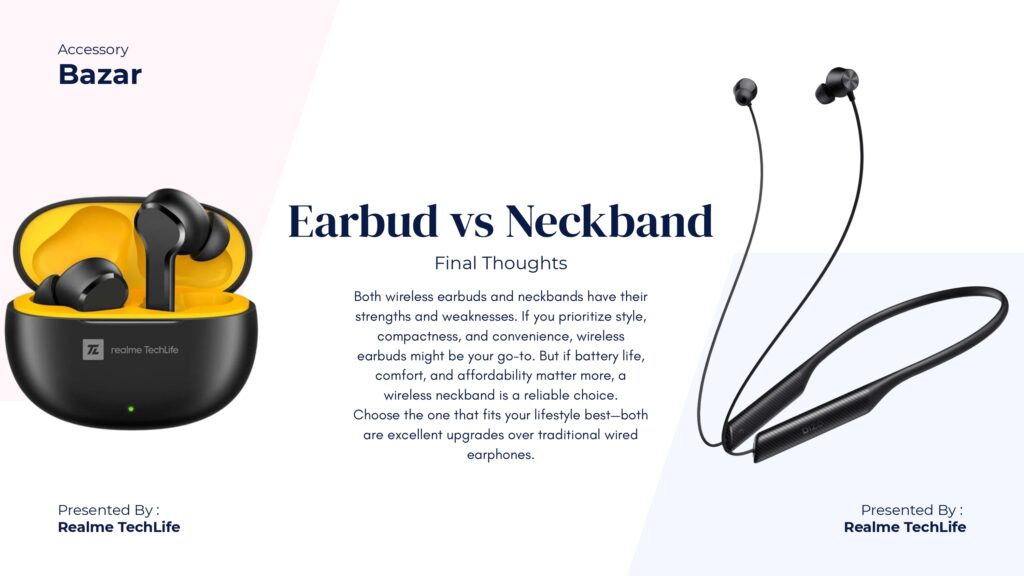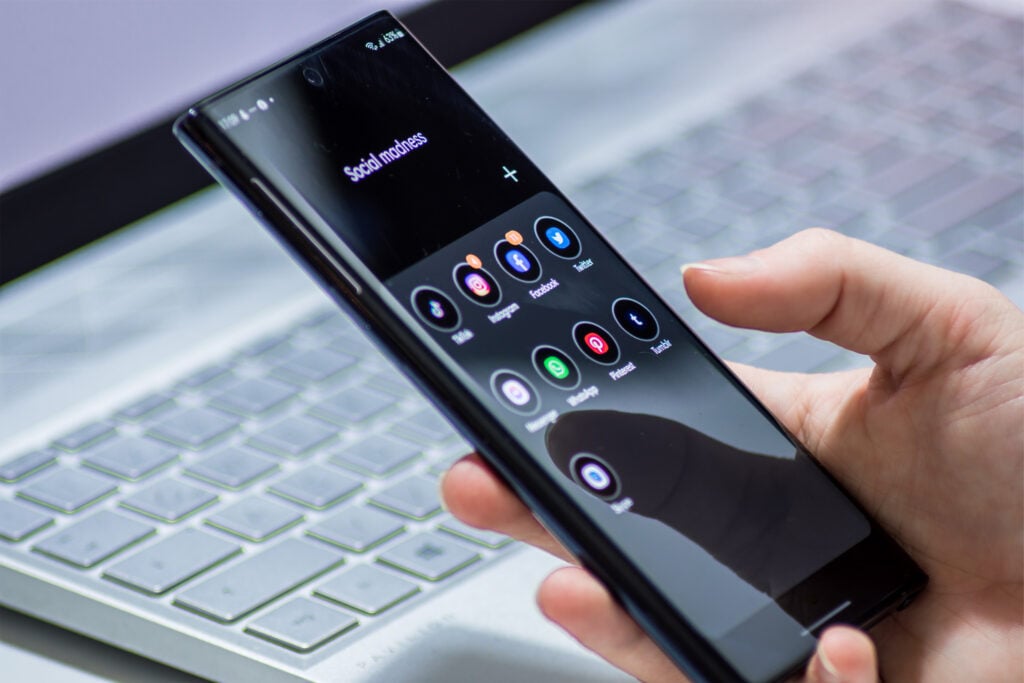In the modern dynamic world, the portable audio equipment has become part of everyday life. Regardless of whether you are commuting, exercising, or simply sitting around, the right audio equipment will make the experience better. Wireless earbuds and wireless neckbands are two of the most trendy varieties of wireless audio accessories. Both of them are intended to fulfill a similar basic role of listening to music or taking a call without a wire, but still, there are some important distinctions between the two in the form of design, functionality, comfort, battery life, and the use case. Let us analyze it.
1. Design and Form Factor

Wireless Earbuds:
Wireless earbuds are small, compact earpieces that fit directly into your ears. True Wireless Stereo (TWS) earbuds come without any cables at all—even between the left and right buds. Each earbud connects independently to your smartphone via Bluetooth and is typically stored in a compact charging case.
Examples: Apple AirPods, boAt Airdopes, Realme Buds Air
Wireless Neckbands:
Neckbands are earphones connected via a flexible band that rests around your neck. The earpieces are attached to this band with short wires. Though they connect wirelessly to your device, the neckband physically links the left and right earpieces.
Examples: OnePlus Bullets Wireless, Sony WI-C200, boAt Rockerz 255
Disclaimer: Prices are at time of the review and subject to change.
Best MacBook: Apple rMBP 16-inch

Tech Specs
- 16-inch LCD touchscreen display
- Intel Core i5-1135G7
- 512GB SSD
- 16GB DD4 Ram
- 10.5 battery hours
- 2 Pounds
Who these are for: If you prefer macOS or need limited tech support, a MacBook is a safe bet. The 16-inch models usually offer the best performance of size, weight, and speed. They’re great for writers, office workers, commuters, and college students.
Why we liked the 16-inch Model:
The 2021 MacBook Air uses an Apple M1 chip that delivers great performance and fantastic battery life. And the keyboard is finally improved with the new switches. But the Air’s light weight, solid construction, and industry-trailing support make it a decent laptop, especially if you also own an iPhone or other Apple devices.
Disclaimer: Prices are at time of the review and subject to change.
As you’re tapping, scrolling, and swiping on your phone, you probably don’t give much thought to the fact that your apps are consuming electricity – just that they’re chipping away at your battery life.
It’s engaging. It’s hopeful. It pushes the plot forward.
Before you click away, disappointed that I brought up something as practical and boring as time management, hear me out. My intent is not to crush your spirits.
Only a quarter of young adults are financially literate. You don’t want to overwhelm them with terrible advice. Best to keep them on track.
JOHN MCCARTHY
The average U.S. iPhone owner uses 1-2 gigabytes of LTE data per month, according to some studies. That data comes at an energy cost that’s opaque, because we can’t see it directly.
You can’t look to your peers in the industry, because all they’re going to tell you is that they are killing it, crushing it, changing the world.
Also Read: Journey towards Design Perfection with Google Studio

To its detractors, love at first sight must be an illusion – the wrong term for what is simply infatuation, or a way to sugarcoat lust.
- Take a social media hiatus. According to a recent survey from Everyday Health, 60 to 70 percent of young adults say they check their social media platforms at least daily. Why not dial that back for the holidays?
- Stick to your new routine. It’s tempting to shake up your typical schedule when the holidays come around, but women’s health expert and BINTO founder Suzie Welsh emphasizes the importance of routine amid the revelry.
- Be intentional about fitness. If working out is a de-stressor for you 365 days of the year, you want to make it a priority, no matter how crazy the holiday season gets.
1. There is always the New Project, the New Opportunity.

Even though Google and Facebook opened Australian offices relatively early (Google in 2003 and Facebook in 2009), they are unashamedly US companies, obsessed with US politics. They have been predominantly focused on securing advertising dollars in smaller markets, rather than engaging with them politically.
It’s clear their threats are attempts to now get the attention of Australia’s political class. And if the platforms follow through.
2. To be successful, follow your passion and see where it leads you. All you have to do is jump right in!

Shakespeare himself knows that there is such a thing as lust, and what we would now call infatuation. He’s no fool. People who exhibit the perfectionism are fearful of failure.
Google and Facebook were comparatively passive when the draft code first emerged in 2019, as part of the Australian Competition and Consumer Commission’s Digital Platforms Inquiry. Providing advance notice of any changes.
Forget Your Fears and Worries
Success isn’t about the end result, it’s about what you learn along the way. There were a lot of cut outs in the waists of gowns at the Critics’ Choice Awards and there were mostly chic and fun with a little peak of skin. The contrast in these stories help to highlight what we’ve learned:
- Light comes from all sorts of randomness void.
- It’s a blessing, but also a terrible defect sensational.
- Smart phones are a massive energy drain.
- Buy SmartMag for your successful site.
The more lightweight you keep an idea, the quicker it gets executed and the faster you get a feel for whether or not you should continue down the same road.
We’d love to show you how to make a great living as a writer. Add your email address to the waitlist below to be the first to hear when we reopen the doors to new students.

